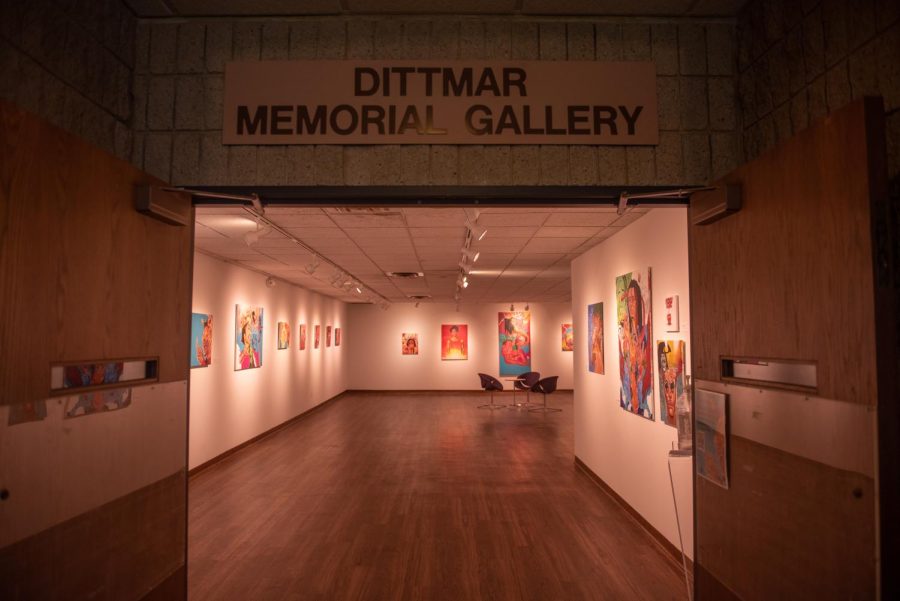Chicago artist Trotter Alexander explores Hawaiian culture in Dittmar Gallery exhibit ‘Ka Makana o’ka’
William Tong/The Daily Northwestern
Dittmar Gallery’s current exhibit, “The Story of Ka Makana o’ ka” by Trotter Alexander, follows a boy from Chicago visiting Hawaii for the first time.
November 7, 2022
Trotter Alexander has been an artist since birth, exploring themes of mental health and racial identity while traversing the worlds of both street art and formal art. His most recent exhibit, “The Story of Ka Makana o’ka,” on display at Dittmar Gallery on campus, runs from Oct. 27 to Dec. 7.
Alexander grew up with his father in Chicago, but would often visit his mother, who lived in Hawaii. The gallery is informed by the different perspectives and cultures of the two locations, Alexander said. The exhibit name itself, “Ka Makana o’ka” means gifted angel in Hawaiian, he said.
The exhibit is a reflection on Alexander’s first time visiting Hawaii as a boy from Chicago.
“When you walk on the soil (in Hawaii), you can really feel the act of spirituality that’s coursing through in the land,” Alexander said. “A lot of people in Chicago don’t give a f–k about the land they are standing on at all. They don’t believe in its preservation because they don’t see a direct consequence. For Hawaii, the ground that you’re on is sacred.”
Deanna Cruz (Communication M.S. ’12), founder and president of the Dandelion Artist Alliance, said Alexander infuses his work with raw and expressive emotion. Cruz said Alexander, who is a member of the alliance, is a modern artist. She said he always has a larger message to deliver through his vibrant colors.
“For as young as he is, I would say that he’s opened up more doors for himself than a lot of the other emerging artists that we have,” Cruz said. “It’s very motivating to hear him speak and hear where his mind is.”
Alexander began working as an assistant in the studio of Chicago artist Czr Prz in 2018. Under Prz’s tutelage, Alexander worked on sculptures and paintings.
Prz said Alexander’s paintings reflect emotions through expressive figures that make dramatic gestures.
“He’s doing a lot of interpretive work,” Prz said.“It’s got a little bit of illustrative, graphic novel, comic bookish aspects to it. He’s following in the footsteps of a lot of Chicago Black artists right now.”
From Prz’s perspective, Alexander is still evolving as an artist — and the best is yet to come.
Chicago singer, songwriter and rapper Senite first learned of Alexander’s work through a live painting event for another musician, where Alexander reflected the sounds and feelings of the music into a live painting.
She described Alexander’s art as a “comfortable chaos” and was impressed with the latest Dittmar exhibit.
“My jaw was on the floor,” Senite said. “I was just amazed at the different mediums that he’s able to put into one piece. It’s like a million pieces, but every one is a completely different feeling, completely different texture, completely different vibe.”
Spray paint, a key aspect of Alexander’s street art, is also widely employed in the exhibit. Alexander said he wanted to combine the aesthetics of street art and traditional Hawaiian art because of spray painting’s anti-elitist nature.
“Street art is supposed to be free, and it’s supposed to be for the people. It’s supposed to be rough. It’s supposed to be loose,” Alexander said. “The nature of the art style translates into an art show. You have unfinished edges, you have paint splatters everywhere.”
For Alexander, art has always been a coping mechanism and mode of catharsis. But he also believes in empowerment and avoiding victimization narratives.
In describing how he depicts depression in his art, he said he focuses on what he has learned instead of what he has suffered.
Recounting a painting of himself screaming with highly saturated fires and aggressive brushstrokes, Alexander said the emotion and passion his paintings evoke give them power, which he hopes resonates with his audience.
“I don’t want you to look at my art,” Alexander said. “I want you to look at my vision.”
Email: [email protected]
Twitter: @JackAustinNews
Related Stories:
— Malika Jackson’s colorful paintings on display at Evanston Art Center explore race and spirituality
— Sharon Hoogstraten’s photography exhibit aims to preserve Potawatomi culture
— Makeba Kedem-DuBose’s colorful works explore race and gender at Evanston Art Center













